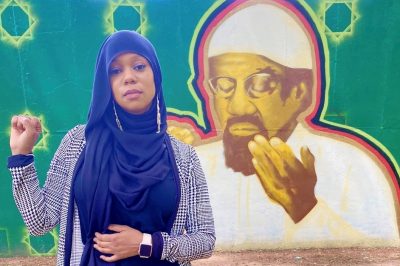This is beyond statues. It is what they represent.
The removal of a statue of Edward Colston, who made his fortune of slavery during the rule of the now defunct British Empire, has been described as ‘utterly disgraceful’ by the UK’s Home Secretary.
Away from the ‘mob rule’ in Bristol, the Mayor of London took almost immediate action by officially removing a statue of another slave trader, Robert Milligan, from outside the London Museum.
? Read Also: How Can Islam Eradicate Systemic Racism
While both Colston and Milligan passed away many years ago, the fact that tributes to them remained for so long, in the form of statues, despite proper, lawful and peaceful protests in the past to remove them, shows how deeply ingrained racism is within our nation.
![A statue of Robert Milligan is pictured being removed by workers outside the Museum of London Docklands [John Sibley/Reuters] A statue of Robert Milligan is pictured being removed by workers outside the Museum of London Docklands [John Sibley/Reuters]](data:image/gif;base64,R0lGODlhAQABAAAAACH5BAEKAAEALAAAAAABAAEAAAICTAEAOw==)
A statue of Robert Milligan is pictured being removed by workers outside the Museum of London Docklands [John Sibley/Reuters]
Statues and Faith
During the early years of the life of Prophet Muhammad, peace be upon him, as well as going to the Cave of Hira in the hours before sunrise to meditate, the Prophet would also frequent the Ka`bah and pray there; even when it was full of idols. His prayers were of course always to God and not to any of the idols.
At that time, the Ka`bah housed over 360 statues within and around it, each of which had their own individual function.
As Prophet Muhammad began preaching the belief in One God, Abu Jahl, one of the Quraish pagan leaders, became so upset at Muhammad praying to Allah at the Ka`bah which was full of idols, that he challenged Prophet Muhammad. It was at this point in history when verses 9-10 of Chapter 96 of the Qur’an were revealed,
“Have you seen the one who forbids the Servant of Allah, when he prays?”
This is God referring to Prophet Muhammad praying to God, while at the Ka`bah full of idols.

Pre-Islamic Art from Saudi Arabia (dpa)
Personal Faith vs Venerating Evil People
For Prophet Muhammad (peace be upon him) and for Muslims who understand the wisdom of faith, it is never about idols, whether religious symbols in the Ka`bah, in a Church, or any other religious institution.
However, when statues on the street represent values of injustice such as slave traders, these are no longer the domain of private faith and more the domain of public discourse. As such, leadership and decency dictates that society deliver the best values and role models to society by removing them.
Muslims of course generally do not have statues of Prophets, but in a multi-faith society where other faith groups do have a culture of statues, what better way to provide a counter-narrative than by erecting statues in the places where Colston, Milligan and other slave traders happened to be, of men and women from history who have done good.
Perhaps to honor those who fought against slavery and did their best to bring justice and equality for all.
After all, Prophet Muhammad (PBUH) spent much of his life encouraging people to set slaves free.
We can argue that while the Prophet did not ban slavery outright in society, for being too embedded in Arab culture, his vision was a world where people are no longer slaves of other people, and remain only, slaves of God.
![A statue of Robert Milligan is pictured being removed by workers outside the Museum of London Docklands [John Sibley/Reuters] A statue of Robert Milligan is pictured being removed by workers outside the Museum of London Docklands [John Sibley/Reuters]](https://aboutislam.net/wp-content/uploads/2020/06/ea982d5f634e455c8b77b6e3e400e0e2_18.jpg)


